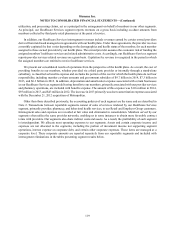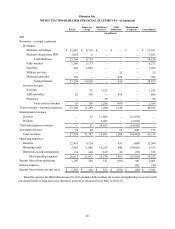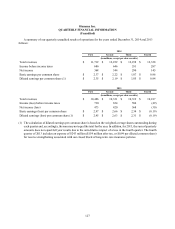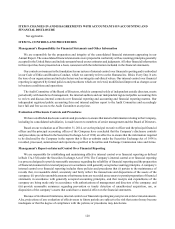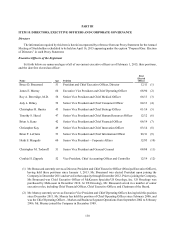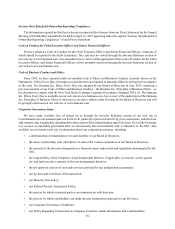Humana 2014 Annual Report Download - page 131
Download and view the complete annual report
Please find page 131 of the 2014 Humana annual report below. You can navigate through the pages in the report by either clicking on the pages listed below, or by using the keyword search tool below to find specific information within the annual report.
Humana Inc.
NOTES TO CONSOLIDATED FINANCIAL STATEMENTS—(Continued)
123
In addition, we establish reserves for future policy benefits in recognition of the fact that some of the premium
received in the earlier years is intended to pay anticipated benefits to be incurred in future years. At policy issuance,
these reserves are recognized on a net level premium method based on interest rates, mortality, morbidity, and
maintenance expense assumptions. The assumptions used to determine the liability for future policy benefits are
established and locked in at the time each contract is issued and only change if our expected future experience deteriorates
to the point that the level of the liability, together with the present value of future gross premiums, are not adequate to
provide for future expected policy benefits and maintenance costs (i.e. the loss recognition date). As discussed in Note
2, beginning in 2014, health policies sold to individuals that conform to the Health Care Reform Law are accounted
for under a short-duration model because premiums received in the current year are intended to pay anticipated benefits
in that year.
The table below presents deferred acquisition costs and future policy benefits payable associated with our long-
duration insurance products for the years ended December 31, 2014 and 2013.
2014 2013
Deferred
acquisition
costs
Future policy
benefits
payable
Deferred
acquisition
costs
Future policy
benefits
payable
(in millions)
Other long-term assets $ 167 $ — $ 166 $ —
Trade accounts payable and accrued
expenses —(68)—(67)
Long-term liabilities — (2,349)—
(2,207)
Total asset (liability) $ 167 $ (2,417) $ 166 $ (2,274)
In addition, future policy benefits payable include amounts of $210 million at December 31, 2014 and $215 million
at December 31, 2013 which are subject to 100% coinsurance agreements as more fully described in Note 19.
Benefits expense associated with future policy benefits payable was $32 million in 2014, $354 million in 2013,
and $136 million in 2012. Benefits expense for 2013 included net charges of $243 million associated with our closed
block of long-term care insurance policies discussed further below. Amortization of deferred acquisition costs included
in operating costs was $39 million in 2014, $55 million in 2013, and $44 million in 2012.
Future policy benefits payable include $1.5 billion at December 31, 2014 and $1.4 billion at December 31, 2013
associated with a non-strategic closed block of long-term care insurance policies acquired in connection with the 2007
acquisition of KMG. Future policy benefits payable includes amounts charged to accumulated other comprehensive
income for an additional liability that would exist on our closed-block of long-term care insurance policies if unrealized
gains on the sale of the investments backing such products had been realized and the proceeds reinvested at then current
yields. There was $123 million of additional liability at December 31, 2014 and no additional liability at December 31,
2013. Amounts charged to accumulated other comprehensive income are net of applicable deferred taxes.
Long-term care insurance policies provide nursing home and home health coverage for which premiums are
collected many years in advance of benefits paid, if any. Therefore, our actual claims experience will emerge many
years after assumptions have been established. The risk of a deviation of the actual interest, morbidity, mortality, and
maintenance expense assumptions from those assumed in our reserves are particularly significant to our closed block
of long-term care insurance policies. We monitor the loss experience of these long-term care insurance policies and,
when necessary, apply for premium rate increases through a regulatory filing and approval process in the jurisdictions
in which such products were sold. To the extent premium rate increases and/or loss experience vary from our loss
recognition date assumptions, future adjustments to reserves could be required.
During 2013, we recorded a loss for a premium deficiency. The premium deficiency was based on current and
anticipated experience that had deteriorated from our locked-in assumptions from the previous December 31, 2010 loss
recognition date, particularly as they related to emerging experience due to an increase in life expectancies and utilization
of home health care services. Based on this deterioration, and combined with lower interest rates, we determined that








